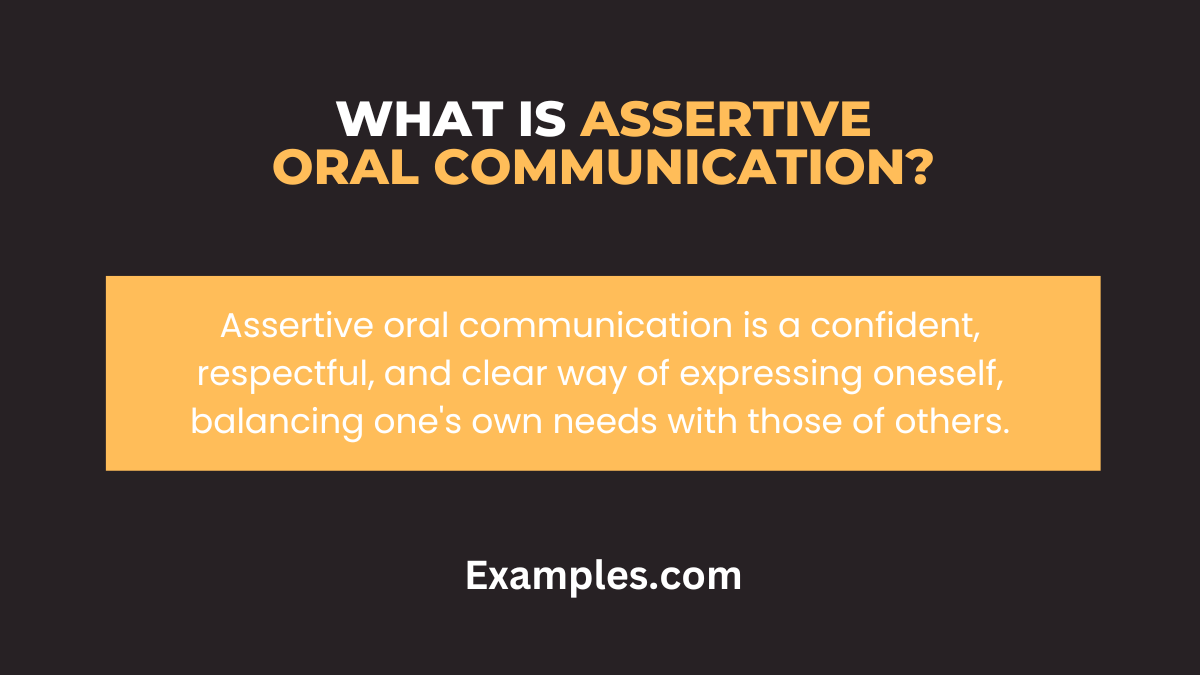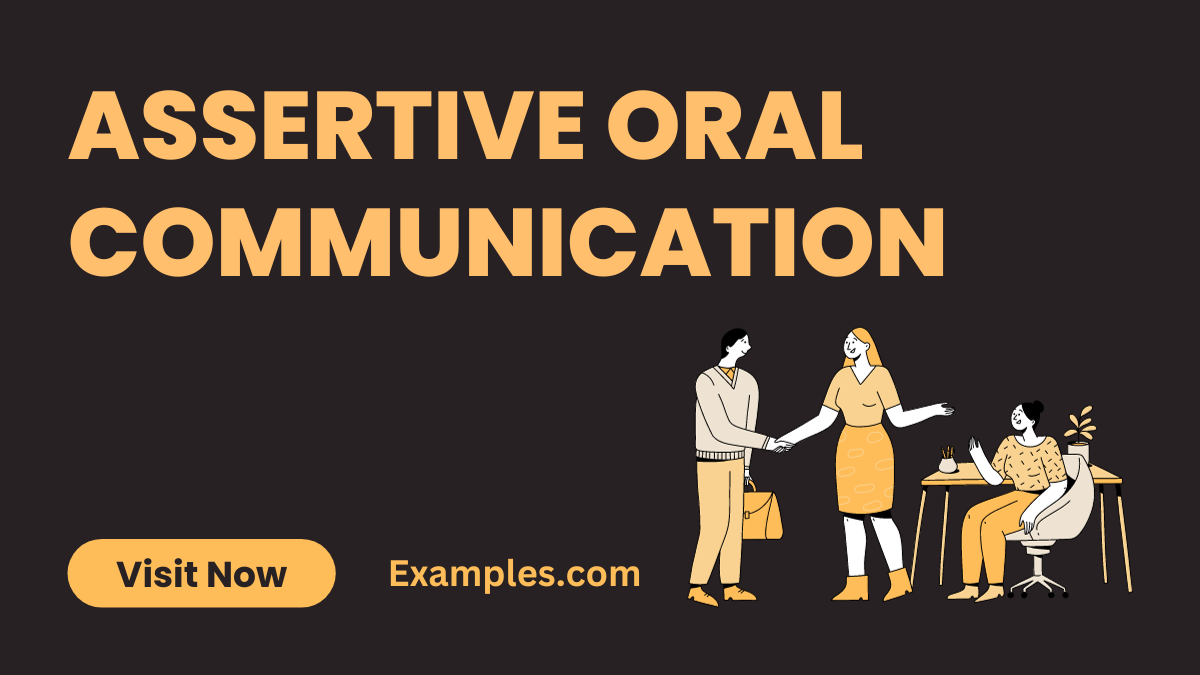Assertive Oral Communication
Assertive oral communication is a crucial skill that combines clarity, confidence, and respect in verbal interactions. It involves expressing oneself effectively and standing up for personal rights while respecting others. This guide will explore the fundamentals of assertive communication, emphasizing the importance of balancing assertiveness with active listening and empathy. Mastering this form of communication is essential for successful interpersonal relationships, both in personal and professional settings, ensuring messages are conveyed clearly and respectfully.
What is Assertive Oral Communication?

Assertive oral communication is a balanced, confident approach to expressing oneself, skillfully combining elements of active listening in Oral Communication and understanding. This method emphasizes clear, concise delivery, and involves actively engaging in conversations with respect and empathy. Key to this style is using confident language and effective nonverbal cues, like making eye contact and maintaining an open posture. Integral in various settings, from personal relationships to professional environments, it’s a vital communication skill that enhances interactions and fosters strong relationships.
30 Assertive Oral Communication Examples
- “I understand your point, but I have a different perspective.”
This phrase shows respect for the other person’s view while confidently presenting your own. - “Can you please elaborate on that?”
Asking for clarification demonstrates active listening and engagement in the conversation. - “I appreciate your feedback; here’s what I think.”
Acknowledging others’ input before sharing your thoughts fosters a respectful dialogue. - “Let’s find a solution that works for both of us.”
This suggests collaboration and respect for mutual interests. - “I feel strongly about this issue because…”
Expressing personal feelings with clarity and confidence. - “Thank you for sharing. Here are my thoughts.”
Gratitude followed by assertive expression of your own ideas. - “I’d like to add my perspective to what you said.”
Politely interjecting your viewpoint into the discussion. - “I disagree, and here’s why.”
Clearly stating disagreement with rational reasoning. - “Your point is valid; however, I see it differently.”
Acknowledging the other’s point while maintaining your stance. - “I’m not sure I agree. Can you explain further?”
Inviting more information while subtly expressing a differing opinion. - “That’s an interesting viewpoint. Here’s mine.”
Showing interest before presenting an alternative perspective. - “I value your input, but my experience suggests otherwise.”
Balancing respect for others’ opinions with your own experiences. - “I hear what you’re saying, but I think we should consider this too.”
Balancing active listening with the introduction of new ideas. - “I understand, but let’s look at it from another angle.”
Encouraging a broader perspective on the topic. - “Let’s discuss this further to understand each other better.”
Promoting deeper conversation for mutual understanding. - “I’m glad you brought that up. Here’s another aspect to consider.”
Showing appreciation for the discussion while adding new insights. - “I see your point, but I have had a different experience.”
Respectfully contrasting your experience with theirs. - “I respect your opinion, but I’d like to explain mine.”
Establishing a respectful ground for expressing differing views. - “That’s a good observation. My take on it is…”
Complimenting before sharing your unique perspective. - “I’m not completely convinced. Could you provide more details?”
Politely expressing skepticism and seeking more information. - “I appreciate your viewpoint. Here’s another perspective.”
Valuing their view while introducing your own. - “That makes sense, but have we considered this?”
Agreeing, yet prompting consideration of additional factors. - “I understand where you’re coming from; my thoughts are…”
Expressing empathy before sharing your thoughts. - “Let’s explore all our options openly.”
Suggesting an inclusive approach to decision-making. - “I would like to contribute my ideas on this subject.”
Politely offering your thoughts to the conversation. - “Your idea has merit, and here’s another angle to it.”
Recognizing the value of their idea while adding to it. - “I’m not entirely in agreement. Here’s my reasoning.”
Assertively stating disagreement with clear rationale. - “That’s one way to see it. Here’s another.”
Introducing an alternative viewpoint to the discussion. - “I get your point, but let’s also consider these factors.”
Understanding their point while broadening the discussion. - “I’d like to hear your thoughts, and then I’ll share mine.”
Facilitating a two-way conversation with active listening and sharing.
Assertive Communication in Nursing

Assertive communication in nursing is crucial for patient care and team collaboration. It involves nurses expressing their needs and concerns clearly and respectfully, ensuring patient safety and effective healthcare delivery. This communication style enhances teamwork, patient satisfaction, and overall nursing practice quality.
Assertive Communication in the Workplace

In the workplace, assertive communication fosters a positive and productive environment. It enables employees to express ideas and opinions confidently while respecting others, leading to improved team dynamics, decision-making, and conflict resolution. This approach is key to professional growth and workplace harmony.
Assertive Communication in Psychology

Assertive communication is a fundamental concept in psychology, promoting healthy interpersonal relationships and self-expression. It helps individuals express their feelings and boundaries without aggression, contributing to better mental health and social interactions. This communication style is often a focus in therapeutic settings to improve personal and professional relationships.
Types of Assertive Oral Communication

Assertive oral communication comes in various forms, each tailored to different situations and audiences.
- Feedback and Criticism: Delivering feedback in a constructive manner, focusing on the issue rather than the person.
- Requests and Refusals: Making clear requests or saying no respectfully, without feeling guilty.
- Conflict Resolution: Addressing conflicts directly and respectfully, seeking a win-win solution.
- Opinion Sharing: Expressing opinions confidently without belittling others’ viewpoints.
- Negotiation: Engaging in discussions where both parties’ needs are considered and addressed.
- Public Speaking: Presenting ideas in front of groups with confidence and clarity.
- Personal Interactions: Communicating effectively in personal relationships, maintaining honesty and empathy.
Components of Assertive Oral Communication
Assertive oral communication is built on several key components:
- Clarity: Being clear and concise in what you say.
- Confidence: Speaking with self-assurance and conviction.
- Empathy: Understanding and considering others’ feelings and perspectives.
- Respect: Valuing others’ opinions and speaking without belittling.
- Honesty: Being truthful in your communication.
- Active Listening: Fully engaging with others’ speech, showing genuine interest.
- Nonverbal Communication: Using appropriate body language like eye contact, gestures, and facial expressions to reinforce the message.
- Feedback: Giving and receiving feedback constructively.
- Adaptability: Tailoring communication style to different audiences and situations.
What are the Strategies of Assertive Oral Communication?
Assertive oral communication, an essential skill in both personal and professional settings, involves several key strategies:
- Clear and Concise Messaging: It’s crucial to deliver your message in a straightforward, clear manner. Avoid over-complicating or diluting your points, ensuring clarity in Oral Communication.
- Active Listening: Beyond hearing, it involves understanding and processing what others say. Active listening in Oral Communication shows respect and openness to different perspectives.
- Empathetic Responses: Display understanding and consideration for others’ feelings and viewpoints, a vital part of understanding in Oral Communication.
- Confident Body Language: Nonverbal cues, such as maintaining eye contact and using assertive gestures, are integral to assertive oral communication, reinforcing your verbal message.
- Positive Framing: Frame your thoughts and responses positively. This encourages constructive dialogue and reduces defensiveness, an aspect of positive oral communication.
- Respectful Disagreement: Learn to disagree without being disagreeable, an important part of confident oral communication.
- Effective Feedback: Constructive and specific feedback is essential, along with being open to receiving feedback, a part of feedback in Oral Communication.
How to Improve Assertive Oral Communication
Enhancing assertive oral communication involves self-awareness and practice. Here are some tips:
- Regular Practice: Practice is key. Engage in conversations that challenge you to be assertive, focusing on active listening in Oral Communication.
- Self-Reflection: Reflect on your communication encounters, considering what worked well and areas for improvement, especially in terms of clarity in Oral Communication.
- Seek Feedback: Ask for honest feedback on your communication style, particularly on aspects like eye contact and active listening.
- Learn from Others: Observe individuals who excel in assertive communication, paying attention to their use of confident oral communication techniques.
- Role-Playing Exercises: Practice different approaches in role-play scenarios, which is a great way to improve feedback in Oral Communication.
- Educational Resources: Utilize resources focused on assertive communication, with an emphasis on understanding in Oral Communication.
- Mindfulness Practices: Engage in practices to improve emotional regulation, a key part of maintaining positive oral communication.
- Incremental Challenges: Start with low-stakes situations and gradually move to more challenging scenarios, enhancing your confident oral communication skills.
Tips for Assertive Oral Communication
Mastering assertive oral communication is key to effective interactions in both personal and professional settings. Here are some practical tips to enhance this skill, with a focus on integrating nonverbal communication cues:
- Utilize Clear and Direct Language: Be specific and clear in your communication. Avoid vague language and ensure clarity in Oral Communication. This straightforward approach helps in minimizing misunderstandings and conveying your message effectively.
- Practice Active Listening: Active listening in Oral Communication is not just about hearing words; it’s about understanding the message behind them. Show that you are listening by nodding or paraphrasing what has been said, which demonstrates your engagement and consideration.
- Maintain Appropriate Eye Contact: Eye contact is a powerful nonverbal cue in assertive communication. It conveys confidence and helps in building trust. However, be mindful of cultural differences in the use of eye contact.
- Express Empathy: Understanding and acknowledging others’ feelings and viewpoints are crucial. This aspect of understanding in Oral Communication creates a respectful atmosphere conducive to open dialogue.
- Use Confident Body Language: Along with verbal messages, your body language should reflect confidence. Stand or sit straight, use open gestures, and maintain an approachable posture, all of which are part of effective nonverbal communication.
- Be Respectful and Positive: Ensure your tone and words are respectful. Using positive oral communication helps in keeping the conversation constructive and prevents it from becoming confrontational.
- Provide Constructive Feedback: Giving and receiving feedback is a core aspect of feedback in Oral Communication. Frame your feedback in a way that is helpful and specific, rather than critical and vague.
- Practice Emotional Regulation: Being able to control your emotions, especially in challenging conversations, is vital. This control is a key part of maintaining positive oral communication and ensuring that the conversation remains productive.
Assertive oral communication, an essential skill for personal and professional growth, serves as a bridge between individual expression and mutual respect. It’s a dynamic tool that empowers individuals to articulate their thoughts and feelings clearly, fostering an environment of understanding and cooperation. In professional settings, this communication style is instrumental in creating a positive, collaborative atmosphere, enhancing team dynamics, decision-making processes, and conflict resolution strategies.
For further learning and development in assertive communication, resources from the American Psychological Association (APA) provide in-depth insights and research on the psychological underpinnings of this communication style. Additionally, the Stanford University School of Medicine offers valuable materials and courses that delve into the art of assertive communication, particularly in healthcare and professional settings.



